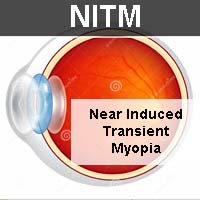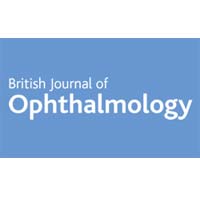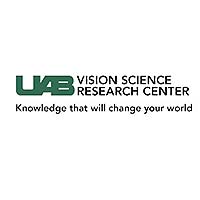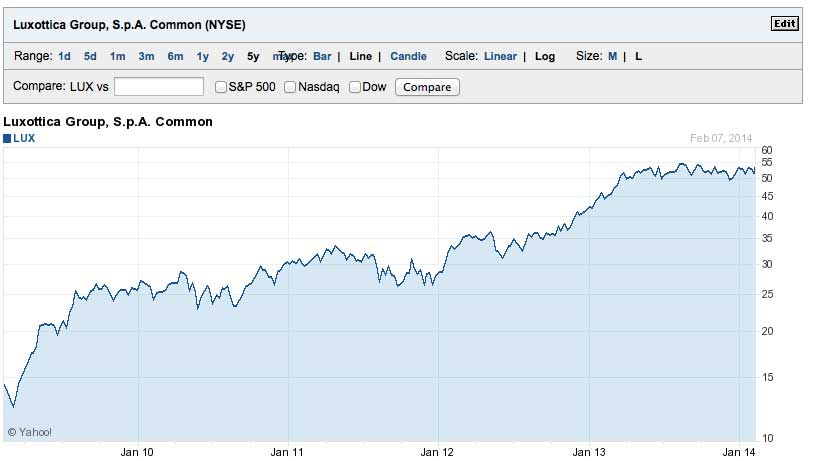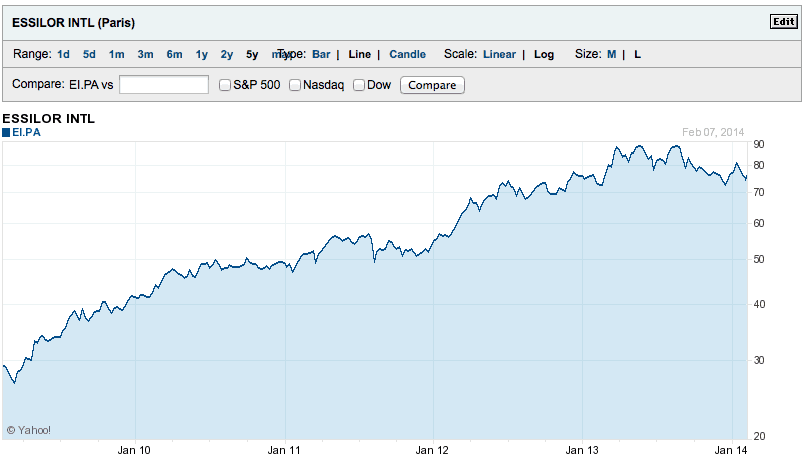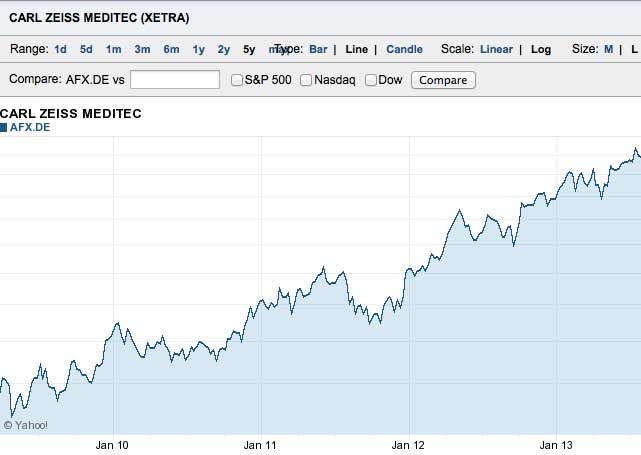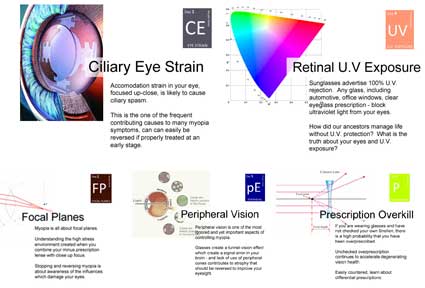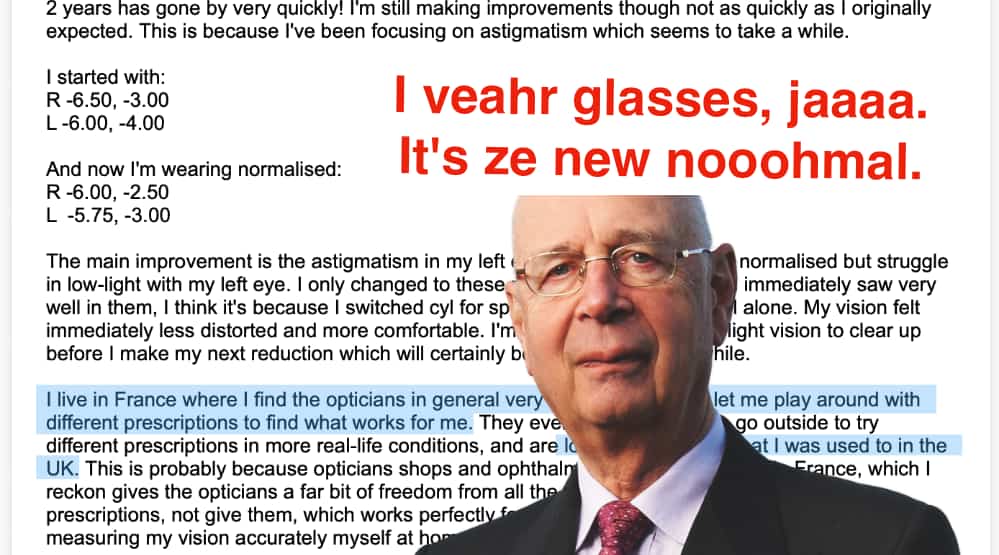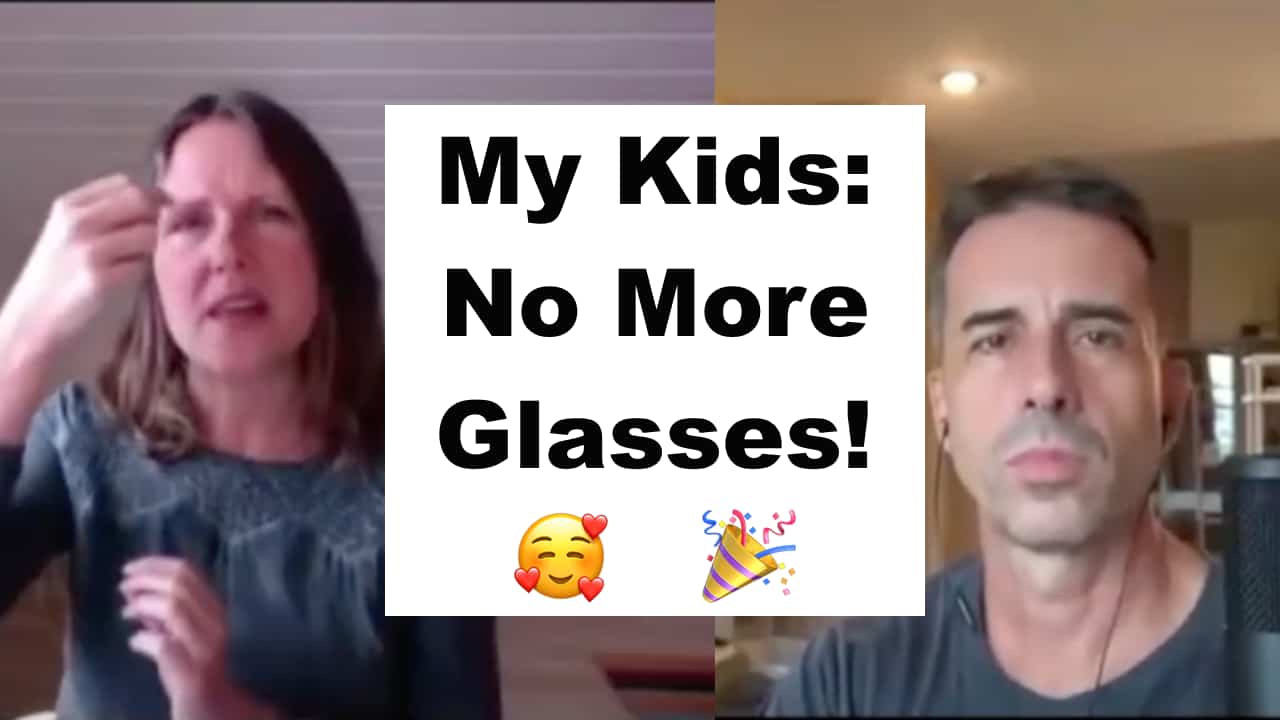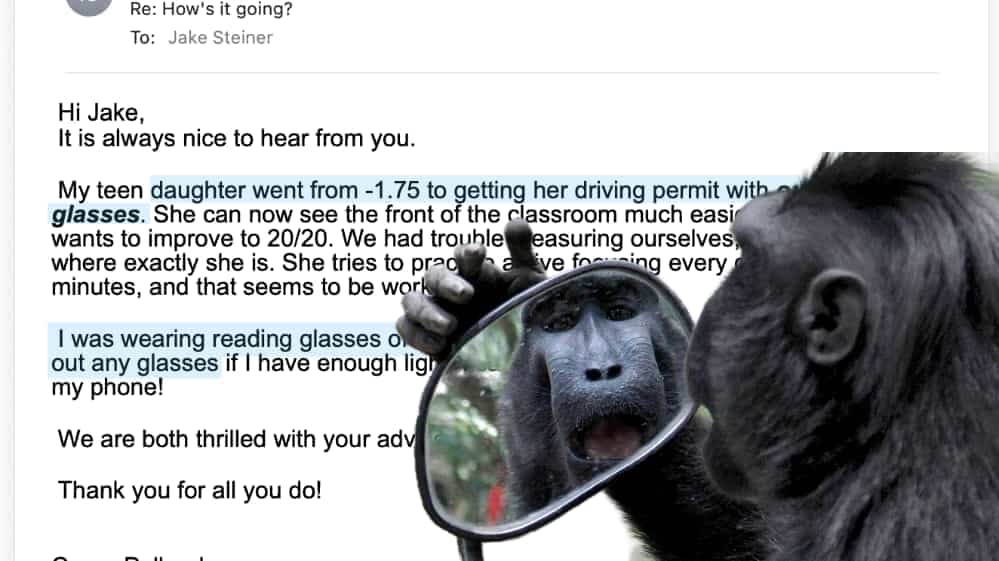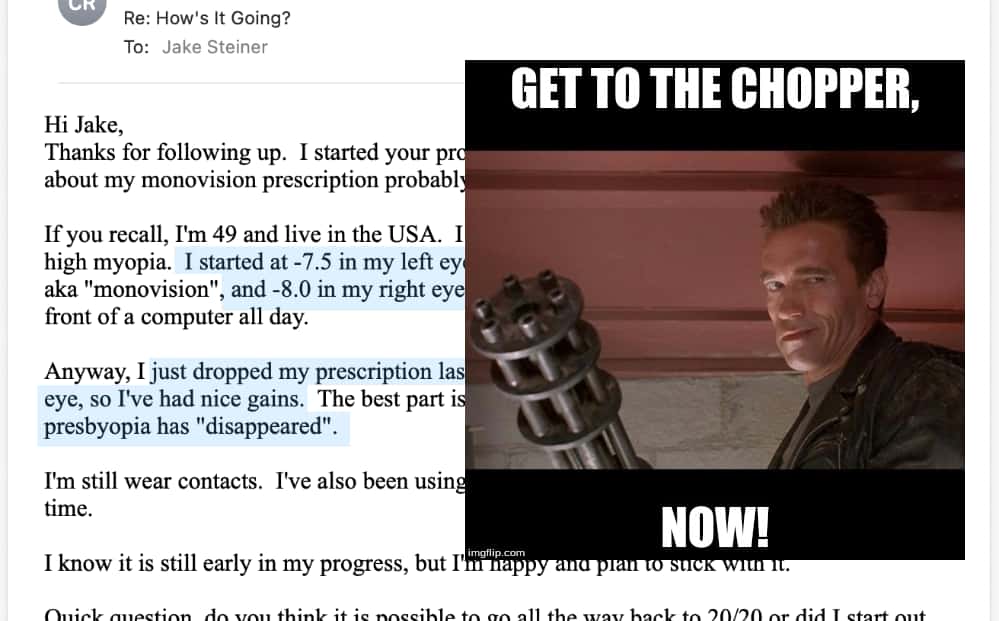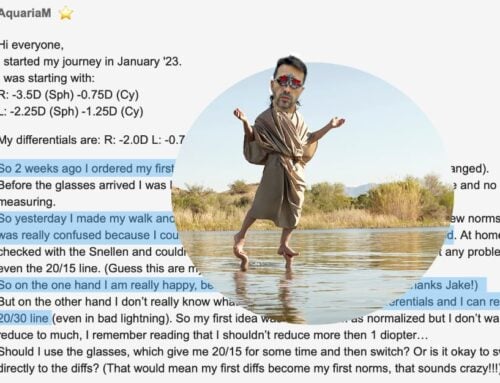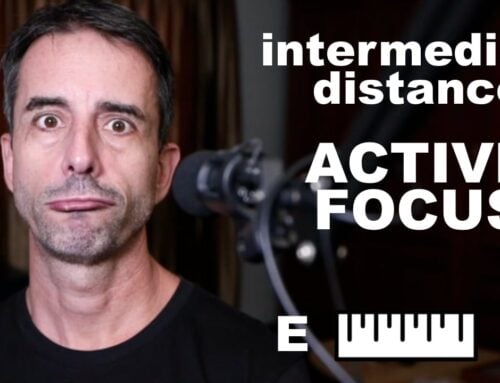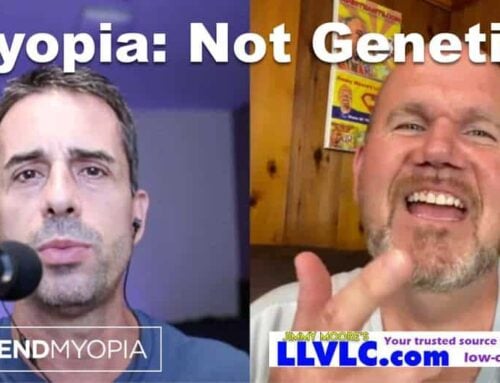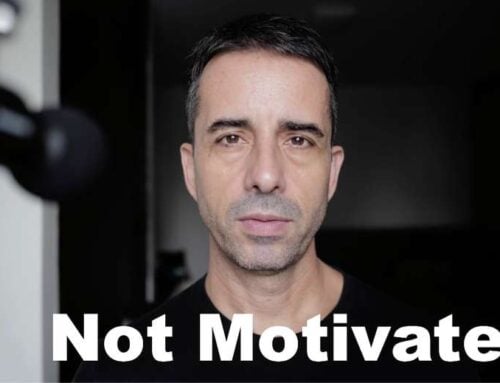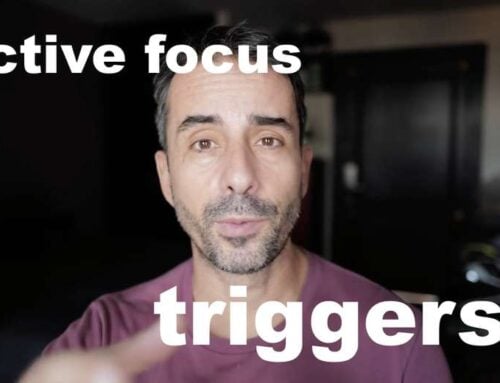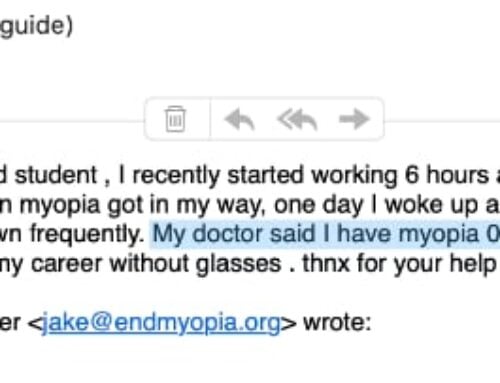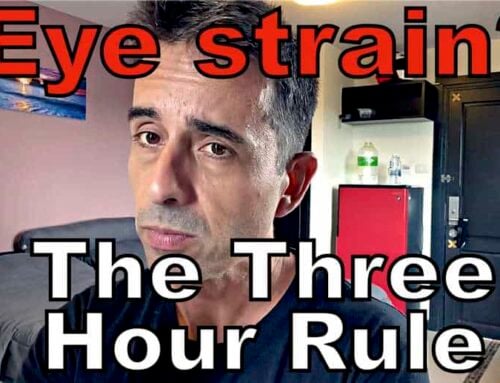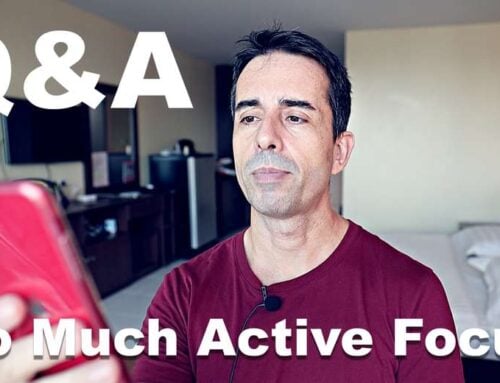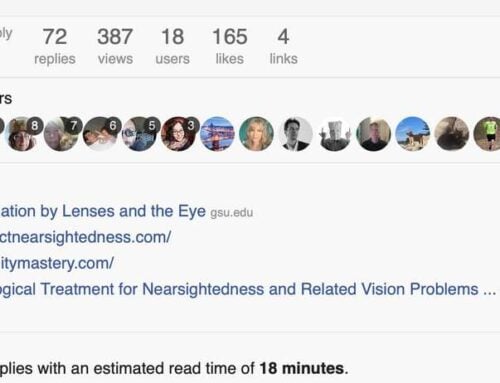All Myopia Starts As A Temporary Symptom
Initial myopia, or pseudo myopia, referred to as NITM, or “near induced transient myopia”, in medical journals.
This is just a spasm of the focusing muscle in your eye (the ciliary). Caused by too much close-up focus, when the muscle is at its most contracted, the symptom is just ‘transient’ – temporary.
While this symptom is diagnosed as myopia and glasses are prescribed, it could easily be reversed at this stage. It isn’t until you begin wearing glasses (the minus lens, as referred to in studies), that your myopia becomes something more dangerous.
Once You Begin To Wear Glasses:
Your Vision Gets Worse
 You will find this phenomenon listed in medical journals and studies as “lens-induced myopia”.
You will find this phenomenon listed in medical journals and studies as “lens-induced myopia”.
When you put a minus lens (your glasses are a minus lens) in front of an eye, be it human, monkey, mouse, or even fish (there are studies on fish!), it becomes myopic. Since the eye is a dynamic organ, it responds to the change in where the light focuses on the retina.
Remember, myopia initially was a focusing muscle spasm. While using a lens to refocus the light seemingly addresses the symptom, it just creates a new problem – progressively increasing myopia.
None of this is news to medical science.
NITM has been coined by medical science, and is mentioned in myopia studies dating back more than 40 years.
Google Scholarly Proves: Science Understands Myopia
10,700 (!) Pages Discussing NITM (Near Induced Transient Myopia)
10,700 pages. Has your optometrist ever mentioned near induced transient myopia, when he/she prescribed your first glasses? Were you ever told that your first myopia symptom was nothing more than a temporary strain symptom, caused by too much close-up?
There would have been zero profit in that treatment. Which is why the retail optometrist is likely not even educated on this topic at all.
Industry publications are clearly aware of this problem:
British Journal of Ophthalmology
“Ophthalmologists should also recognise and take up the challenge of preventing or curing myopia by addressing its cause and not simply treating the consequences.”
 State University of New York
State University of New York
“The relation between myopia and near work has been reasonably well established in humans […] This includes the environmental factor of near work-induced transient myopia (NITM).”
The University of Waterloo
“The visual environment is an important factor controlling ocular development in lower vertebrates, as well as in higher ones, and eye development is not strictly genetically determined.”
 Wayne State University
Wayne State University
“In vivo high-resolution analysis of changes in ocular components and refractive state of the eye upon induction of experimental myopia in mice.”
The University of Alabama
“A minus-power lens placed in front of the eye produces increased axial elongation and a myopic shift […]“
Clearly, myopia is well researched and well understood in the medical science community. This is absolutely not the case on the retail level – where the bulk of the education is centered on creating lens prescriptions and selling fashion glasses and contact lens technology.
We hope to provide you with a more health focused approach to myopia, here.
Who Not To Ask About How To Improve Eyesight
This may sound cynical, but it’s a fact: the optic shop is in business
selling you things that keep you coming back.
If they focused on how to improve eyesight, they would be out of business soon. And the ones who educate them (the optic shop), are huge, multi-billion dollar a year lens manufacturers. There is nobody in the chain of corporate vision health, interested in how to improve eyesight.
And again, no need to take my word for it:
That is Luxottica’s last five years of stock performance. What do they sell? Fashion frames. Unlike most of the stock market, these guys have consistent year over year revenue increase.
This is not an isolated example. Another:
And that is Essilor. French lens manufacturer. Your lenses are quite possibly made by them.
That’s their five year stock trend. There are billions of dollars at stake, not improving your eyesight. There is more:
Here is Zeiss lens manufacturing five year stock trend. We could easily find a dozen more of these.
Acuvue, the contact lens maker, did 64 BILLION dollars in business last year alone. Why don’t any of these guys tell you how to improve eyesight? Above, the billion dollar answer. Your optometrist is just the last guy in that chain of sales. The guy telling you that “there is no cure for myopia”, is the sales guy of these lens manufacturers. That might be a bit blunt, but how else can you reasonably put it?
That’s it. That’s all there is to know. NITM, lens-induced myopia, billions of dollars in profit to keep your eyes behind lenses.
Ophthalmologists Are In On The Profit Scheme
It would be easy for you to say … “Alex, now you are talking crazy.” But let’s have PBS and the Wall Street Journal do the talking, instead of me.
Do you know what the top paid medical profession in Medicare payouts is?
Do you know how much money the professionals make, who tell you that myopia can’t be cured, and that only surgery or lenses can manage your eyesight?
Take a look at this shocking article on how much your eyesight is really a profit motivated business. Let’s look at highlights of the full and disturbing story, from this PBS article:
WASHINGTON — Medicare paid a tiny group of doctors $3 million or more apiece in 2012. One got nearly $21 million.
Those are among the findings of an Associated Press analysis of physician data released Wednesday by the Obama administration, part of a move to open the books on health care financing. Topping Medicare’s list was Florida ophthalmologist Salomon Melgen.
In the $3 million-plus club, 151 ophthalmologists — eye specialists — accounted for nearly $658 million in Medicare payments, leading other disciplines.
***
(Link: Wall Street Journal original research.)
Who makes the most money? Ophthalmologists. Who supports their education, and the product sales? Lens manufacturers.
Who tells you that myopia can’t be cured, that we don’t understand the cause (though clearly we do)?
Who claims that only their advice is the truth, and that only lenses or surgery can manage your eyesight?
Who tries to silence anyone who dares to suggest that myopia is manufactured illness?
And while this site, the idea of myopia being reversible may sound far fetched, we hope you are beginning to see how much profit is the main motivation of the industry.
Keep in mind that this isn’t just me, Alex, asking you to trust me. Go to Google Scholar, or PBS, or The Wall Street Journal, and see for yourself.
NITM And Lens-Induced Myopia
Once you have NITM and get an incorrect treatment plan from the optometrist (incorrect being glasses instead of some simple habit changes), you end up with lens-induced myopia. This is where the trouble starts, and where you eyesight continues to get worse. Here again, a quick search on Google Scholarly reveals that this isn’t any kind of news to anyone in the medical field. Hundreds of studies ranging from high school students, to monkeys, mice, birds, and even fish, all show that putting a minus lens in front of the eye causes increasingly poor eyesight.
It is at the NITM stage, that the question of how to improve eyesight should stop the whole progression. Unfortunately that isn’t the case.
Of course so far, none of this requires a leap of faith on your part. There isn’t any question about these facts.
The only question is, why your optometrist has no earthly clue about what medical science, and science journals in his/her field have been discussing for decades.
Once you are clear about the cause, it’s time to look at some changes:
Start Looking At Glasses As Temporary Crutch
Glasses shouldn’t be replacing your healthy eyesight.
They should be a crutch to help regain it. Remember lens-induced myopia? Glasses are pretty dangerous, if abused. You experienced this already, with ever increasing prescriptions. Of course you shouldn’t just stop wearing glasses, that won’t accomplish anything. When we look at how your eyesight got worse, and in reverse, how to improve eyesight, prescriptions are a big piece of the puzzle. And dialing back to a level where your eyes have to work for focus, is a very good idea.
There are two key concepts here, which you will want to understand very well – the blur horizon and active focus.
Of all the things on this site, understanding those two concepts will get you the furthest.
And before you ask why nobody else talks about this – we don’t know. But we have been doing this for as many as 40 years, and a lot of it has come from trial and error, client feedback, reading all those clinical studies your optometrist has been busy ignoring, and looking for solutions rather than prescriptions.
Why Eyesight Exercises Don’t Really Work
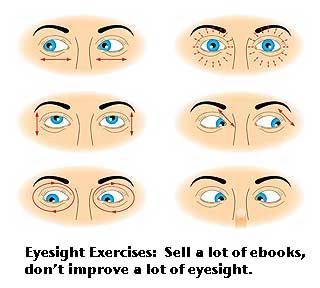 The same reason most diets don’t have a long term positive effect on weight, eye exercises just give you temporary improvements.
The same reason most diets don’t have a long term positive effect on weight, eye exercises just give you temporary improvements.
They sound interesting, they sell lots of books and online programs, but we rarely hear of anyone who improved their vision using some exercise regimen. We are certainly not opposed to anything that works – but doing a set of odd (and most not exactly a natural use of your eyes) exercises every day hardly has anything to do with addressing the cause of myopia (remember, NITM and lens-induced).
The real key to vision improvement is positive, targeted habit change.
There is absolutely no way around this – we have to get a better set of close-up habits to resolve the NITM problem. And once we do that, we have to address prescription use and prescription strength to get you working on positive stimulus (active focus) for your regular lifestyle.
All of this means an up-front learning curve, habit building, and then basically “auto pilot” for ongoing improvement, and natural eyesight that will last.
40 Years of Myopia Rehabilitation Experience
 It’s time to explore myopia recovery based on an integrative eyesight health paradigm. Not profit-first, based on research science rather than retail optometry.
It’s time to explore myopia recovery based on an integrative eyesight health paradigm. Not profit-first, based on research science rather than retail optometry.
After as many as 40 years in the business of helping clients improve their eyesight through rehabilitation, we found that very little has changed. Your choices in finding a legitimate alternative to glasses or surgery are still few and far between. Even with the reach of the Internet now at our fingertips, there very little meaningful discussion about eyesight health.
We hope to provide you with some education about your eyesight, and what happened to your 20/20 vision.
This isn’t another “eyesight exercises” site. We don’t suggest you use Bates Method, or pinhole glasses, Ortho-K, or any of the other various methods with questionable benefit.
Start Improving Your Eyesight
Instead of letting your eyesight continue to deteriorate, increasing your risk of retinal detachment later in life, you can start taking preventative measures right now.
We Put Together A Step-By-Step Program to Improve Your Eyesight.
Take just 20 minutes a day, three days per week, to get your healthy eyesight back.
This program is the optimized, condensed, best practices of everything from our practitioners 40 years in helping clients get back their healthy eyesight. We leave out all the things that aren’t entirely necessary, and focus on the aspects that give you the most improvement.
The program is also mainly focused on habit changes, rather than eye exercises.
Why?
Eye exercises simply don’t work, long term.
You might be excited for a while and try them, but then life takes back over. What you need is a way to change your consistent habits in a way that makes them automatic, and require no ongoing effort on your part. The only thing that ever works, we have learned, is habit changes.
The Vision Improvement Course is all about getting you into healthy eyesight habits.
The support forum is entirely uncensored, and open for you to read anytime. Just click the “Support” button on top of every page – it shows all participant questions, feedback, and stories. we added the forum for transparency and to help build a community around eyesight improvement.
Donation Supported & Free Options
We want you to improve your eyesight.
Everything you need, is available for free in the blog and forum – the paid course just organizes the content into a step-by-step approach.
If you prefer to work with the free content, we also have a small free course (via e-mail), to get you the basics – from there you can read the free materials, and find everything you need to improve your eyesight. The choice is yours! (find the free course in the blog)
Either way, please take some time to learn about how to stop mistreating your eyes.
Enjoy!
Latest Posts From The Eyesight Health Blog:
Rules are meant to be ... obeyed. Jaaa.
Retail optometry loves to overcomplicate things. And sell them to you.
Your kids don't need glasses. Unless you listen to those who sell them.
Presbyopia reversed, he says. Even though there's still +0.50 diopters left.
It won't be long now, darlings. Checking in on Twitter for a few minutes every morning, watching clown-world unfold. It seems we're really serious about going as completely r*tarded as possible, while simultaneously building [...]


